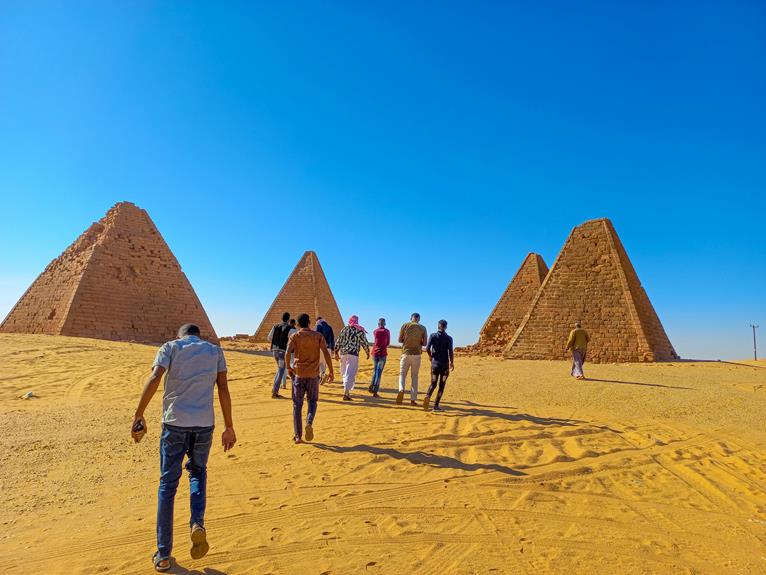The Valley of the Kings in Egypt, renowned for its enigmatic tombs and ancient mysteries, has long fascinated historians and archaeologists alike. Its labyrinthine passageways and hidden chambers hold secrets waiting to be unraveled, shedding light on the beliefs and customs of one of the world's most intriguing civilizations. As we explore the depths of this necropolis, we are confronted with tantalizing questions about the pharaohs who once ruled Egypt and the afterlife they meticulously prepared for. Join us on a journey through time as we investigate the depths of this enthralling valley and discover the untold stories that lie within.
Key Takeaways
- Royal necropolis for New Kingdom pharaohs.
- Transition from pyramids due to instability.
- Focus on afterlife passage and wealth preservation.
- Significant archaeological discoveries like Tutankhamun's tomb.
- UNESCO World Heritage Site with rich cultural legacy.
History of the Valley of the Kings
What events led to the establishment of the Valley of the Kings as a prominent burial site in ancient Egypt?
The Valley of the Kings, located on the west bank of the Nile near Thebes, became the royal necropolis for the New Kingdom pharaohs of Egypt. This shift from traditional pyramid burial sites to the hidden valley was influenced by several factors.
Initially, the increased instability during the Third Intermediate Period made the pharaohs opt for more secure and hidden burial sites to protect their remains and treasures from grave robbers. The valley's natural terrain, with its cliffs and desolate surroundings, provided a more defensible location for the tombs.
Royal burials in the Valley of the Kings were not only about laying the pharaoh to rest but also ensuring their safe passage to the afterlife. The intricate decorations, elaborate burial chambers, and the inclusion of valuable artifacts and ancient treasures in the tombs reflected the Egyptians' belief in the afterlife and the importance of preserving wealth and possessions for the ruler's use in eternity.
The meticulous planning and construction of these tombs demonstrate the significance placed on the pharaoh's shift to the next world and the preservation of their legacy for eternity.
Archaeological Discoveries in the Valley
Numerous significant archaeological discoveries in the Valley of the Kings have shed light on the burial practices, beliefs, and daily life of ancient Egypt's New Kingdom pharaohs. Recent excavations in the Valley have unearthed secrets that captivate the imagination and provide invaluable insights into the past.
- The Tomb of Pharaoh Seti I: One of the most remarkable finds in the Valley of the Kings is the tomb of Pharaoh Seti I. Discovered in 1817 by Giovanni Battista Belzoni, this tomb is renowned for its intricate decorations and impressive architecture, offering a glimpse into the grandeur of New Kingdom burial rites.
- The Discovery of KV5: KV5, a subterranean tomb complex, was unearthed in 1995. Believed to be the tomb of the sons of Ramesses II, this vast underground structure contains multiple chambers and corridors, revealing the familial ties and dynastic succession of the ancient Egyptian rulers.
- The Finding of the Tomb of Horemheb: In 1975, the tomb of Pharaoh Horemheb was discovered in the Valley. This discovery provided valuable information about the reign of this lesser-known pharaoh and added to our understanding of the political and religious landscape of the New Kingdom.
These archaeological discoveries continue to enrich our knowledge of ancient Egypt, offering a profound connection to the past and inspiring further exploration and research.
Tomb of Tutankhamun: A Legendary Find
The legacy of significant archaeological finds in the Valley of the Kings culminates in the legendary discovery of the tomb of Tutankhamun, a pivotal moment in Egyptology that continues to captivate scholars and enthusiasts worldwide. Discovered by Howard Carter in 1922, Tutankhamun's tomb is renowned for the vast array of treasures it contained, providing unprecedented insights into ancient Egyptian funerary practices and beliefs.
Tutankhamun's treasures, including his iconic golden mask, intricate jewelry, chariots, and various funerary objects, have not only shed light on the opulence of the New Kingdom but have also offered clues about the young pharaoh's life and death. The meticulous preservation of these artifacts has allowed researchers to piece together the story of Tutankhamun's reign and the rituals associated with his burial.
The excavation techniques employed by Carter during the discovery of Tutankhamun's tomb marked a significant advancement in archaeological practices. Carter's meticulous approach, characterized by the systematic recording of each item found and the careful removal of artifacts, set a new standard for future excavations in the Valley of the Kings.
The tomb of Tutankhamun stands as a symbol to the wealth and craftsmanship of ancient Egypt, while also serving as a reminder of the mysteries that continue to be uncovered in the sands of the Valley of the Kings.
Architecture and Design of Tombs
Architectural integrity and intricate design elements play a pivotal role in the construction of tombs within the Valley of the Kings, reflecting the sophisticated craftsmanship and symbolic significance of ancient Egyptian burial sites. The architecture of the tombs is a confirmation of the deep-rooted beliefs and rituals surrounding death and the afterlife in ancient Egypt. Here are three aspects that evoke a sense of wonder and reverence among visitors:
- Architectural Symbolism: The layout and structure of the tombs were carefully planned to align with the Egyptian beliefs regarding the journey of the soul in the afterworld. The intricate maze-like corridors, hidden chambers, and the placement of the sarcophagus within the tomb all held symbolic meanings connected to the passage from earthly life to the divine domain.
- Intricate Design Elements: The walls and ceilings of the tombs are adorned with elaborate hieroglyphics, paintings, and carvings that depict scenes from Egyptian mythology, religious texts, and the pharaoh's life. These detailed designs not only serve an aesthetic purpose but also carry significant meaning related to the deceased's journey to the afterworld.
- Burial Rituals: The tombs were not merely places of internment but served as stages for elaborate burial rituals performed by priests and family members of the deceased. These rituals, including the mummification process and the deposition of grave goods, were integral to ensuring the deceased's successful passage to the afterlife according to ancient Egyptian beliefs.
Significance of Wall Paintings and Hieroglyphics
Reflecting the profound beliefs and cultural practices of ancient Egyptian burial traditions, the wall paintings and hieroglyphics found within the tombs of the Valley of the Kings serve as intricate narratives that convey the symbolic significance and spiritual essence of the afterlife journey. These intricate artworks provide a glimpse into the symbolic world of the ancient Egyptians, offering valuable insights into their beliefs about the afterlife and the journey of the deceased.
The wall paintings in the tombs are rich in symbolism, with each color, motif, and figure carrying deep meaning. For instance, the depiction of the deceased receiving offerings from various gods symbolizes the sustenance needed for the afterlife journey. Similarly, scenes showing the weighing of the heart against the feather of Ma'at represent the judgment of the soul in the afterlife.
Hieroglyphics, the ancient Egyptian writing system, play a significant role in the interpretation of these wall paintings. The intricate texts provide additional context to the scenes depicted, offering prayers, spells, and instructions to aid the deceased in their journey to the afterlife. Through a careful interpretation of these hieroglyphics, scholars have gained a deeper understanding of ancient Egyptian religious beliefs and practices.
| Symbolism | Interpretation |
|---|---|
| Colors | Represent different deities |
| Ankh symbol | Symbol of life and immortality |
| Solar disc | Representation of the sun god Ra |
| Lotus flower | Symbol of rebirth and regeneration |
| Djed pillar | Symbol of stability and endurance |
Mummification Practices in Ancient Egypt
In the intricate domain of ancient Egyptian funerary customs, mummification stands as a revered practice embodying the meticulous preservation of the deceased for their journey into the afterlife. The ancient Egyptians believed in the continuity of life after death, and mummification played a vital role in guaranteeing the preservation of the body for the soul's use in the afterlife.
- Embalming Techniques: The embalming process was a complex ritual that involved removing the internal organs, desiccating the body with natron salts, and wrapping it in linen bandages. This intricate procedure was conducted by skilled embalmers who were often considered sacred in their profession, showcasing the reverence the ancient Egyptians held for the deceased.
- Burial Rituals: The act of mummification was closely tied to elaborate burial rituals that included prayers, rituals, and the placement of amulets within the mummy wrappings. These rituals were performed to make certain the deceased had a safe passage into the afterlife and could navigate the challenges they might encounter on their journey.
- Symbolism and Beliefs: Mummification was not only a physical process but also a deeply symbolic one. The preservation of the body symbolized the eternal nature of the soul, while the rituals surrounding mummification reflected the Egyptians' profound beliefs in the afterlife and the importance of proper burial practices for a successful progression into the next world.
Conservation Efforts and Challenges
The conservation of the artifacts and structures within the Valley of the Kings in Egypt presents a pivotal challenge requiring meticulous planning and innovative strategies. The environmental impact on the tombs and temples due to factors such as humidity, temperature fluctuations, and carbon dioxide levels poses a significant threat to their preservation. To combat these issues, preservation efforts focus on maintaining stable environmental conditions through ventilation systems and barriers that regulate moisture and temperature.
Modern technology plays a vital role in the restoration and conservation of the Valley of the Kings. Advanced imaging techniques like 3D laser scanning and ground-penetrating radar enable experts to assess the condition of the structures without causing physical harm. Additionally, digital mapping and documentation aid in monitoring changes over time and planning conservation interventions effectively.
Restoration projects within the Valley of the Kings require a delicate balance between preserving the authenticity of the sites and ensuring their structural integrity. Conservationists employ specialized techniques such as consolidating fragile surfaces, cleaning without causing damage, and using compatible materials for repairs. These endeavors aim to safeguard the cultural heritage of the Valley of the Kings for future generations while respecting the historical significance of the monuments.
Tourism in the Valley: Visitor Experience
Given the historical significance and ongoing conservation efforts within the Valley of the Kings in Egypt, understanding the impact of tourism on the visitor experience becomes an important aspect of preserving this renowned archaeological site. When visitors begin a journey to explore the tombs of pharaohs and ancient Egyptian treasures, their experience is shaped by several key factors:
- Visitor Amenities: The availability of essential facilities such as restrooms, shaded areas, and information centers greatly influences the comfort and enjoyment of tourists. Proper amenities not only cater to the practical needs of visitors but also enhance their overall experience, allowing them to explore further into the wonders of the Valley without distractions.
- Ticket Prices: The affordability and transparency of ticket prices play a significant role in attracting a diverse range of visitors. Reasonable pricing ensures that the Valley remains accessible to a broader audience, fostering inclusivity and promoting cultural exchange. Conversely, exorbitant fees may deter potential visitors, limiting the opportunity for many to appreciate this unique historical site.
- Guided Tours: Knowledgeable guides can enrich the visitor experience by providing in-depth insights into the history, significance, and symbolism of the tombs. Guided tours offer a structured exploration of the Valley, providing visitors a deeper understanding of the ancient civilization that once thrived in this sacred necropolis.
Theories and Debates Surrounding the Valley
Scholars and experts in the field of Egyptology continue to engage in rigorous debates and formulate intriguing theories surrounding the Valley of the Kings. One of the primary areas of contention revolves around the purpose behind the construction of the tombs within the valley. While traditionally believed to be solely for the burial of pharaohs, some scholars propose alternative theories suggesting that the valley may have also served as a center for religious ceremonies or even as a place of initiation into the afterlife.
Controversies also exist regarding the layout and design of the tombs. Some researchers argue that the positioning of the tombs was not random but rather meticulously planned based on astronomical alignments or significant topographical features. Others debate whether the decoration and inscriptions within the tombs hold symbolic meanings beyond their initial interpretations, leading to further exploration and analysis.
Moreover, ongoing discussions surround the methods and technologies used in the construction of the tombs. The precision of the cuts, the transportation of massive stone blocks, and the intricate artwork raise questions about the level of sophistication achieved by ancient Egyptian artisans and engineers. These debates and theories continue to fuel research and excavations in the Valley of the Kings, keeping the mysteries of this ancient burial ground alive for future generations to unravel.
Legacy of the Valley of the Kings
Amidst the ongoing debates and theories surrounding the Valley of the Kings lies a profound exploration into its lasting impact and significance, encapsulated within the concept of the 'Legacy of the Valley of the Kings.' This legacy extends far beyond the physical tombs and artifacts unearthed in this ancient necropolis, delving into its cultural impact and modern relevance.
- Preservation of Ancient History: The Valley of the Kings stands as a confirmation to the rich cultural heritage of ancient Egypt, preserving not only the grandeur of pharaonic burials but also providing invaluable insights into the beliefs, practices, and daily life of this civilization. It allows us to connect with our past and understand the traditions that have shaped human history.
- Inspiration for Art and Architecture: The grandeur and sophistication of the tombs in the Valley of the Kings have inspired countless artists, architects, and creatives across the globe. From intricate hieroglyphics to the awe-inspiring design of the burial chambers, the Valley continues to influence modern artistic endeavors, serving as a timeless muse for creativity.
- Educational Significance: As a UNESCO World Heritage Site, the Valley of the Kings stands as an educational hub, offering scholars, historians, and enthusiasts a window into the ancient world. Its modern relevance lies in the ongoing research, discoveries, and interpretations that contribute to our understanding of the past, fostering a sense of intellectual freedom and curiosity.
Frequently Asked Questions
What Is the Significance of the Valley of the Kings to Modern Egyptian Culture?
The significance of archaeological sites like the Valley of the Kings to modern Egyptian culture lies in their role in cultural preservation.
These sites offer valuable insights into ancient traditions, beliefs, and practices, contributing to a deeper understanding of Egypt's rich heritage.
How Were the Tombs in the Valley of the Kings Protected From Grave Robbers?
Security measures in protecting ancient tombs were integral to thwarting grave robbers. Intricate architectural designs, hidden passageways, and false chambers were common tactics.
Tomb decoration often included elaborate hieroglyphs and artwork to honor the deceased.
The historical context reveals a society deeply rooted in belief in the afterlife, necessitating such safeguards to guarantee the safe passage of the deceased into the next world.
Are There Any Unknown Tombs or Chambers yet to Be Discovered in the Valley?
Exploration and excavation efforts have revealed tantalizing possibilities of hidden treasures within various historical sites worldwide. Revealing unknown tombs or chambers remains a compelling pursuit for archaeologists, offering the promise of unraveling secrets of the past.
The allure of undiscovered riches and artifacts underscores the importance of continued exploration in ancient sites, fueling the curiosity and dedication of researchers and historians alike.
How Do Experts Determine the Age and Identity of Mummies Found in the Valley?
In the field of archaeology and forensic science, experts determine the age of mummies through various methods such as radiocarbon dating, examination of burial practices, and analysis of associated artifacts.
Identifying the identity of a mummy involves a multidisciplinary approach, including DNA analysis, facial reconstruction, and comparison with historical records or inscriptions.
These techniques provide valuable insights into the lives, lineage, and societal roles of individuals preserved in ancient tombs.
What Impact Did the Discovery of the Valley of the Kings Have on the Field of Egyptology?
The discovery of the Valley of the Kings had a profound impact on the field of Egyptology. It revolutionized archaeological techniques, offering insights into ancient burial practices and the historical context of Egyptian royalty.
Excavation methods and scientific analysis were elevated to new heights, enabling researchers to unravel mysteries of the past with unprecedented precision.
This significant find continues to shape our understanding of ancient civilizations and their funerary traditions. What enduring secrets lie buried beneath the sands of time?
Conclusion
To sum up, the Valley of the Kings in Egypt stands as a remarkable demonstration of the ancient Egyptian civilization's beliefs, practices, and architectural achievements.
Through the intricate hieroglyphics, hidden tombs, and ongoing conservation efforts, this site continues to unveil new insights into the rich history of the pharaohs.
The legacy of the Valley of the Kings remains a fascinating subject of study and exploration, attracting visitors and researchers alike with its enduring mysteries and historical significance.


